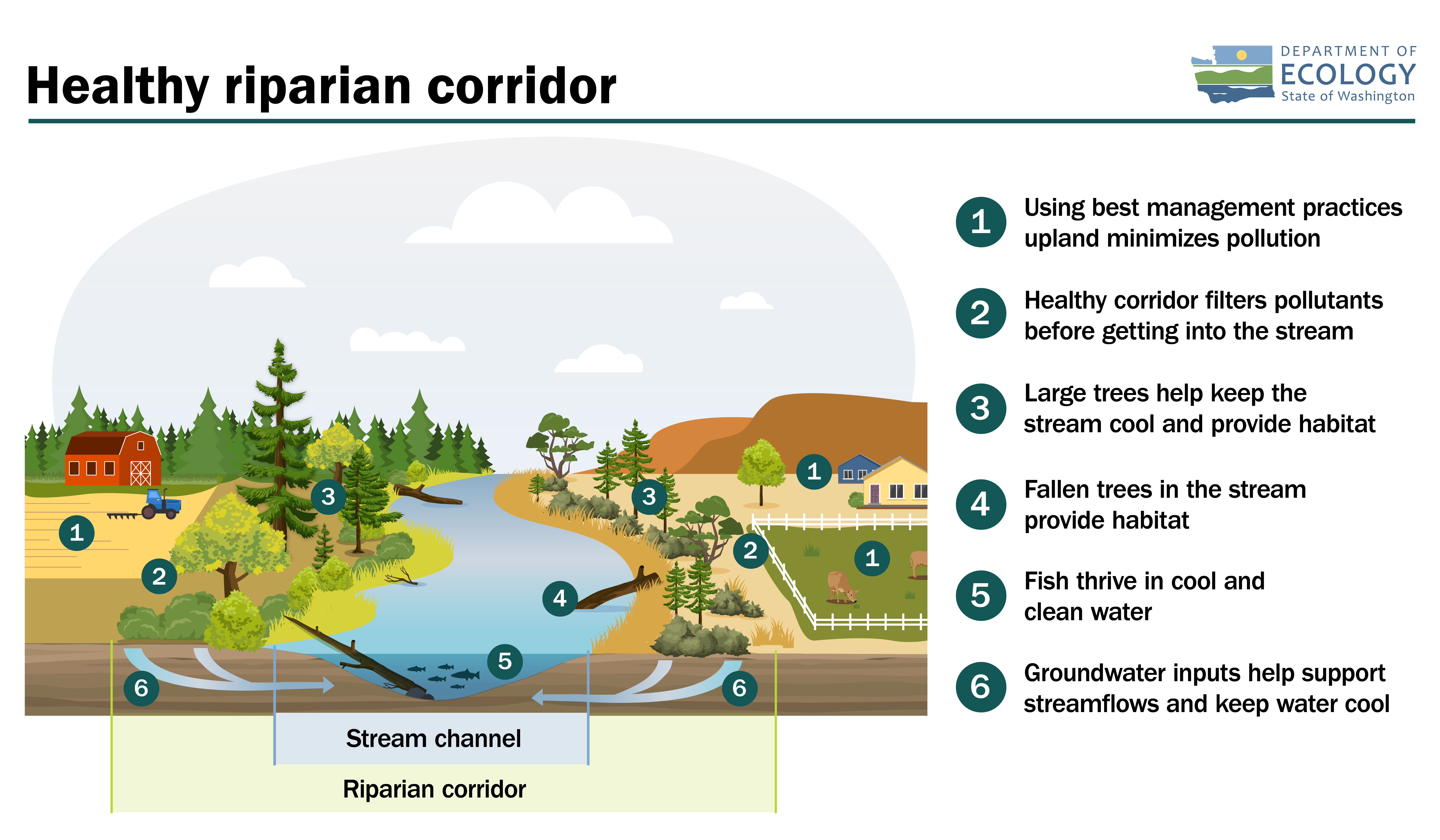Temperature pollution
Clean and cool water is vital to salmon recovery across Washington. Industry and land use practices, including agriculture, logging and development, can impact streamside plants and contribute to increased water temperatures. We work with local partners and landowners to restore and protect trees and other plants along Washington's waterways.
How does increased temperature impact water quality?
Temperature plays an important role for the health of water bodies and affects in-stream plant and animal species:
-
Salmon and other aquatic species need cool water to survive and maintain healthy populations.
-
Warm water is more likely to have algal blooms which can suffocate fish, contaminate shellfish, and be unsafe for human use, leading to closures.
-
As climate change progresses, it is vital to support the resilience of our waterbodies to better cope with more extreme weather conditions and threats from increased temperatures.
Keeping Skagit Valley Wild and Cool: The Impact of Warm Streams
Learn more about high water temperatures and how it threatens the wild nature of Skagit Valley and beyond.
What increases temperature in streams?
A leading cause of increased water temperatures throughout the state is loss of trees, shrubs, and other plants along streams and rivers. These areas, called riparian buffers, provide shade that help regulate temperature and keep water cool. Buffers also help filter out pollutants, reduce erosion, and can help minimize the impacts from flooding. Streamside vegetation can be impacted by many things, including development, cultivation, and livestock access to the area.

A healthy riparian buffer is important to supporting the health of in-stream and adjacent ecosystems.
What is our role?

Provide recommendations to protect water quality
We work with interest groups and partner agencies to develop Best management practices (BMPs) to address nonpoint sources of temperature pollution. We published a Clean Water Guidance chapter on Riparian Areas and Management with our 2022 Nonpoint Plan. Read our guidance focus sheet to learn more.

Provide funding to implement solutions
We provide technical and financial assistance to local partners and landowners to help get water quality solutions on the ground. Our funding programs support streamside vegetation that help waterways meet water quality standards. We're piloting new incentive programs and exploring new opportunities with our partners to keep water clean and cool.

Work with partners
We work with other agencies and local partners across the state to regulate water quality and implement practices that support healthy water temperature. For example, we collaborate with Washington State Department of Natural Resources to help ensure that forestry activities are protective of water quality, including temperature. We also partner with Conservation Districts and provide funding for programs. Finally we work directly with landowners and nonprofits to support agricultral practices that protect cool water.
Restoring Riparian Areas in the Palouse Region
Listen to partners and landowners discuss the importance of trees and cool water solutions in the Palouse.
What can you do to help keep streams cool?
Protecting and restoring streamside vegetation provides multiple benefits to us and our environment!
Do you own land?
If you have a streamside habitat already in place, it is important to protect it. If there are streams or other waterways on your property that don't have adjacent trees or other vegetation, we recommend adding native trees and shrubs to the area. Our local nonpoint field staff and funding programs are here to help you plant streamside vegetation!
Don’t own land?
You can still help! Attend a local volunteer event to plant trees next to streams in your community, or install a local rain garden, which can help increase groundwater flow to streams during the dry summer months.
Keeping Skagit Valley Wild and Cool: Landowner Stories and Solutions
Hear stories from landowners who are taking action to protect the water and wildlife on their land, including solutions to address high water temperature.
Related links
- Statewide Environmental Incident Report Report Form (ERTS)
- Water Quality Management Plan to Control Nonpoint Sources of Pollution
- Water quality funding
- Water quality improvement projects
- Skagit Valley's Warming Waters: Keeping our Skagit Wild and Cool Storymap
Contact information
Nonpoint Source Pollution
Ben Rau
Watershed Planning Unit Supervisor
ben.rau@ecy.wa.gov
360-742-6529

